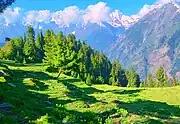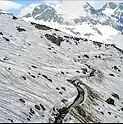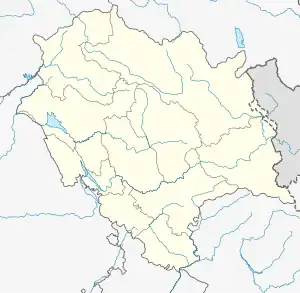Pangi Valley
Pangi is a tehsil of Chamba, Himachal Pradesh, India. The Pangi Valley is a poorly developed tribal area, as well as one of the most remote areas in Himachal Pradesh state. The Pangi Valley is divided into the Saichu, Hudan Bhatori, Anch Chaloli and Sural Bhatori valleys, which are inhabited at elevations of 7,000 feet (2,100 m) to 11,000 feet (3,400 m) above sea level. The Valley is bordered by Padder, Jammu and Kashmir in North, Lahaul and Spiti in West and Chamba in Southeast. The Sach Pass at the elevation of 4,414m is the only route connecting Pangi with District headquarter Chamba.
Pangi Valley (Killar) | |
|---|---|
[[File:  [[File:  [[File:  [[File:  [[File:  clockwise from top left:pangi valley as seen from kumar village,pasture in pangi valley,shiva peak,sach pass,chandrabhaga river near phindru village . | |
 Pangi Valley (Killar) Location in Himachal Pradesh, India  Pangi Valley (Killar) Pangi Valley (Killar) (India) | |
| Coordinates: 33.084014°N 76.406980°E | |
| Country | India |
| State | Himachal Pradesh |
| District | Chamba |
| Government | |
| • Type | Himachal Pradesh Legislative Assembly |
| • Body | Janak Raj (politician) |
| Area | |
| • Total | 1,601 km2 (618 sq mi) |
| Population (2011) | |
| • Total | 18,868 |
| • Density | 12/km2 (31/sq mi) |
| Languages | |
| • Official | Hindi |
| • local | Pangwali |
| Time zone | UTC+5:30 (IST) |
| PIN | 176323 |
| Vehicle registration | HP 45 |
History
People are said to have arrived in the valley thousands of years ago.There are only folk tales and stories indicating human presence in the valley.local legend has it that the Raja of Chamba would cover the funeral expenses of government officials who were making their trip to Pangi Valley for official business. There was no certainty that they would return because of the great isolation. [1].It is also said that the King of Chamba exiled criminals to the other side of the Sach Pass, where they eventually established civilization. It is also said that during Mughal attacks, Rajput warriors sent their families into the Himalayan high valleys to protect them, but after they were defeated and killed, their families stayed and populated the region. One theory holds that people from lower Chenab came here in search of agricultural land.
Villages
The Sansari Checkpoint marks the start of the Pangi Valley. Luj is the valley's first village, located at an elevation of 2400 metres. The Dharwas village follows, followed by the villages of Kutha, Anch, Chaloli, and Sural. Killar, the headquarter of Pangi valley is located at an elevation of 2700m along the Chandrabhaga river (Chenab). The villages Mindhal, Phindru, Sach, Purthi, and Shaor follow. The valley of Lahaul begins after Tindi.
Transport
Roads are poor, with few of them surfaced. The Saach Pass at an altitude of 14,500 feet (4,400 m) is open for vehicular traffic between mid-June and October, but closed by heavy snow at other times of the year.[2] Pangi is accessible by vehicle all year round via Paddar Valley (Jammu & Kashmir) but it's a long route as one has to go to Jammu and from there to Paddar along the Chenab river valley.

Demographics
The Pangi tehsil covers 1,601 square kilometres (618 sq mi), and had a population of 18,868 at the 2011 census. Pangi has 16 panchayats and 54 inhabited villages. With recent improvements to the roads, the villagers have started to grow cash crops such as peas, apples and other fruit.[2] The upper reaches of the valley are inhabited by Pangwala and Bhoti people, who are mostly Hindu with a small minority of Buddhists. Attempts are being made to develop the area for tourism, focused on trekking through the dramatic scenery.[3]
Spoken languages
Basically in pangi two Zones/Belt are there by the divination of their ancestors like Bunush & Bhiyunsh with a little bit difference of language. Language spoken by the Pangi people is Pangwali.[4] Language spoken by Bunush and Bhiyunsh is part of Pangwali. Two linguists are working with Pangi people for Pangwali language development. Phonology, grammar and discourse analysis have been done. Tubari, a Pangwali monthly magazine, is regularly published in the valley. Pangwali literature is under development; some titles are Baau pyar (stories of father's love), a Pangwali-Hindi grammar book and Manihelu, a booklet on proverbs and idioms. All of these materials are available on the Pangi website. In 2013 the debut Pangwali language development website was launched in three languages: Pangwali, Hindi and English.
Tourism
The Pangi Valley was described by Dr. J Hutchison (in 1904) as follows:
- "Pangi is unique in its grandeur and beauty: in this respect far surpassing any other portion of Chamba District. The scenery is sublime and imposing, and nature appears in her wildest and grandest moods. Everything is on a stupendous scale. The great river rolls along In a deep and narrow gorge, lashing itself into fury against the adamantine cliffs that confine it. Precipices spring from the brink, in places almost perpendicular, to a height of one or two thousand feet: on the lower ranges are grassy slopes of rich pasture with dense forests of pine and cedar, while high over all, the stern and majestic mountains, piled on one another, attain in altitude of 18,000 to 21,000 feet rising far beyond the line of eternal snow. But all is not sublimity and grandeur. Every few miles the traveler reaches fairly open nooks of surpassing beauties, which may have been small lakes in some bygone age, while the river was cutting its way through a rocky barrier in front. There the villages are chiefly to be found. These are few in number, and of small size, for the region is sparsely inhabited."[5]
References
- https://mysterioushimachal.wordpress.com/2022/06/22/once-known-as-himachals-kala-pani-the-pangi-valley/
- "Pangi: An Idyllic Mountain Valley". 123himachal.com. Retrieved 17 December 2011.
- "Pangi Valley". Himachal Tourism. Archived from the original on 28 December 2011. Retrieved 17 December 2011.
- "Ethnologue: Languages of the World".
- Quoted in: Bharnager, Surender Moha (3 December 1964). Singh, Ram Chandra Pal (ed.). Census of India 1961 (PDF) (Report). Vol. XX Part VI Himachal Pradesh. p. 1.
Appendix III (pages 83-6) is Extract from the Punjab States Gazetteer, Vol XXII A, Chamba State, 1904 (pps. 261–266) by Dr. Hutchinson
Appendix IV (pages 87-8) is Extract taken from Guide to Dalhousie, The Chamba state and the neighbouring Hills compiled by Captain J. B. Hutchinson. Revised by B. A. Rose, C.S., Assistant Commissioner, Dalhousie, 1890, and J. Hutchinson, L.R.C.P. & S.E., Chamba Mission